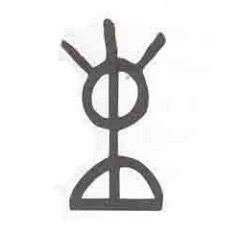For my final project for Computational Approaches to Typography, I wanted to make a sigil#Chaos_magic) generator. In chaos magic, a postmodernist, D.I.Y. system of occult practices dating back to the 1970s, a sigil is a magically charged symbol that helps the magician realize a desire or intent.

Why am I talking about chaos magic in a class on typography? Well, it turns out that the most common process for creating sigils involves layering and deconstructing letters.
Here’s a short passage from Grant Morrison’s Pop Magic that explains the technique:
“The sigil takes a desire or intent - let’s say ‘IT IS MY DESIRE TO BE A GREAT ACTOR’ (you can, of course, put any desire you want in there) and folds it down, creating a highly charged symbol. The desire is then forgotten. Only the symbol remains and can then be charged to full potency when the magician chooses.
…
First, remove the vowels and the repeating letters to leave a string of consonants - TSMYDRBGC.
Now start squashing the string down, throwing out or combining lines and playing with the letters until only an appropriately witchy-looking glyph is left.”
When I first read this, it struck me that this process could be done algorithmically without necessarily invalidating its magical purpose. Once a sigil is made, the magician needs to forget its associated intent before it can be properly charged with power, which might actually be a little easier if the sigil wasn’t made by hand.
In fact, someone else already had this exact idea and made sigilscribe.me. But, as far as I can tell, that generator doesn’t actually use letter glyphs from a font in its sigils.
So, I wanted to try generating sigils by layering letter glyphs from opentype.js and then removing or combining segments of each glyph’s path until I got something that looked sigil-esque.
To be honest, I didn’t have enough time to figure out a good algorithm for this. I got as far as layering the glyphs on top of each other and playing with randomly removing segments from the glyph paths, using Rune.js and a approach adapted from a gist on splitting SVG paths into pieces.
The results…don’t look great. I think with a few more days to play around with this project, I could get something that actually looks like a sigil, but I just came up with the idea a bit too late. I think there’s some potential here, and I’d like to keep working on this after the semester’s over.